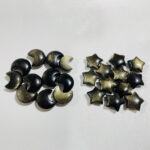Glow in the dark gemstones have fascinated humans for centuries, capturing their imagination with their eerie and intriguing glow. These precious minerals possess the remarkable ability to absorb and release energy in the form of light, creating an enchanting spectacle that captivates and inspires.

Fluorescence and Phosphorescence
The glow emitted by gemstones is a result of two primary phenomena: fluorescence and phosphorescence. Fluorescence occurs when a gemstone absorbs ultraviolet light and immediately re-emits it, resulting in a visible glow. Phosphorescence, on the other hand, involves the absorption and storage of energy, which is gradually released as light over a longer period, causing the gemstone to glow even in the absence of external light.
Types of Glow in the Dark Gemstones
Various gemstones exhibit glow in the dark properties, each with its unique characteristics and applications.
1. Zircon
Zircon is a zirconium silicate mineral known for its exceptional fluorescence and is often used in jewelry and decorative applications. It emits a bright blue or green glow under ultraviolet light, making it a popular choice for mood jewelry and artistic creations.
2. Sphalerite
Sphalerite is a zinc sulfide mineral that emits a characteristic orange-red glow when exposed to ultraviolet light. It is frequently used in jewelry due to its vibrant fluorescence and is known as “fire blende” in the mineral world.
3. Willemite
Willemite is a zinc silicate mineral prized for its intense green fluorescence. Its high durability and resistance to fading make it an excellent choice for lighting applications and artistic designs.
4. Kunzite
Kunzite is a variety of spodumene mineral that exhibits a soft pink to purple fluorescence. It is often used in jewelry and is particularly popular in spiritual and meditative practices due to its calming and soothing energy.
Applications of Glow in the Dark Gemstones
The unique glow of these gemstones has led to a wide range of applications in various industries:
1. Jewelry
Glow in the dark gemstones are popular choices for jewelry, creating captivating pieces that evoke a sense of wonder and intrigue. They are often incorporated into pendants, earrings, rings, and bracelets, adding a touch of magic to everyday outfits.
2. Decorative Applications
These gemstones are frequently employed in decorative applications, illuminating art installations, home décor, and architectural elements. Their ability to emit light in darkness transforms ordinary spaces into captivating and ethereal realms.
3. Lighting
Gemstones with strong phosphorescence are valuable in lighting applications, where they are used to create low-level, long-lasting illumination. This energy-efficient technology is finding increasing use in night lighting, emergency lighting, and decorative lighting.
4. Research and Technology
Glow in the dark gemstones have significant applications in research and technology. Their ability to absorb and release energy has led to advancements in fields such as nuclear physics, medical imaging, and chemical analysis.
Fluorescence and Phosphorescence Intensity
The intensity of fluorescence and phosphorescence in gemstones can vary significantly. Factors influencing the intensity include:
- Impurities: The presence of certain impurities or trace elements can enhance or diminish fluorescence and phosphorescence.
- Crystal Structure: The arrangement of atoms within the gemstone’s crystal structure plays a crucial role in determining its light-emitting properties.
- Heat Treatment: Exposure to high temperatures can alter the internal structure of the gemstone, affecting its glow.
- Exposure to Light: Prolonged exposure to natural or artificial light can gradually diminish the gemstone’s ability to emit light.
Creating Glow in the Dark Gemstones
It is possible to create artificial glow in the dark gemstones through a process known as radioluminescence. This involves exposing the gemstone to radioactive materials, which cause the gemstone to absorb energy and emit light.
However, it is important to note that radioluminescence can pose health risks, and special precautions must be taken when handling such materials.
Benefits of Glow in the Dark Gemstones
- Unique Aesthetics: Their captivating glow adds a touch of wonder and magic to any application.
- Energy Efficiency: Phosphorescent gemstones provide a sustainable and energy-efficient source of illumination.
- Research and Innovation: Their unique properties contribute to advancements in various scientific and technological fields.
- Therapeutic Properties: Some believe that the energy emitted by glow in the dark gemstones can promote healing and well-being.
Cautions and Considerations
- Fading: Over time, the fluorescence and phosphorescence of gemstones can diminish due to exposure to light and other factors.
- Synthetic Gemstones: Synthetic gemstones can be created to mimic the glow of natural gemstones, but their longevity and durability may differ.
- Radioactive Materials: It is crucial to avoid using radioactive materials to create glow in the dark gemstones due to the associated health risks.
Step-by-Step Approach to Incorporating Glow in the Dark Gemstones into Jewelry
- Choose the Gemstone: Select a gemstone with strong fluorescence or phosphorescence, such as zircon, sphalerite, or willemite.
- Design the Jewelry: Create a design that showcases the gemstone’s glow, considering the size, shape, and setting.
- Expose to Light: Charge the gemstone under ultraviolet light or sunlight to activate its fluorescence or phosphorescence.
- Set the Gemstone: Securely set the gemstone in the jewelry piece using appropriate techniques.
- Enjoy the Glow: Marvel at the captivating glow of the gemstone in darkness or low-light conditions.
Table 1: Fluorescence and Phosphorescence Characteristics of Common Glow in the Dark Gemstones
| Gemstone | Fluorescence Color | Phosphorescence Duration |
|---|---|---|
| Zircon | Blue, Green | Short |
| Sphalerite | Orange-Red | Moderate |
| Willemite | Green | Long |
| Kunzite | Pink, Purple | Short |
Table 2: Applications of Glow in the Dark Gemstones by Industry
| Industry | Applications |
|---|---|
| Jewelry | Pendants, Earrings, Rings |
| Decorative | Art Installations, Home Décor |
| Lighting | Night Lighting, Emergency Lighting |
| Research and Technology | Nuclear Physics, Medical Imaging |
Table 3: Factors Affecting Fluorescence and Phosphorescence Intensity in Gemstones
| Factor | Effect on Intensity |
|---|---|
| Impurities | Can Enhance or Diminish |
| Crystal Structure | Determines Light-Emitting Properties |
| Heat Treatment | Can Alter Internal Structure |
| Exposure to Light | Can Gradually Diminish Glow |
Table 4: Benefits and Considerations of Glow in the Dark Gemstones
| Benefits | Considerations |
|---|---|
| Unique Aesthetics | Fading Over Time |
| Energy Efficiency | Synthetic Gemstones |
| Research and Innovation | Radioactivity Hazards |
Frequently Asked Questions (FAQs)
Q1: Can glow in the dark gemstones lose their glow?
A1: Yes, over time, the fluorescence and phosphorescence of gemstones can diminish due to exposure to light and other factors.
Q2: Are glow in the dark gemstones safe to wear?
A2: Yes, natural glow in the dark gemstones are generally safe to wear, but it is important to avoid exposure to radioactive materials, which can pose health risks.
Q3: How long do glow in the dark gemstones last?
A3: The duration of the glow depends on the type of gemstone and the intensity of the light it absorbs. Some gemstones, such as willemite, can glow for several hours, while others may glow for only a short period.
Q4: Can glow in the dark gemstones be used as light sources?
A4: Phosphorescent gemstones can be used to provide low-level, long-lasting illumination in situations where traditional light sources are impractical or unavailable.
Q5: What is the difference between fluorescence and phosphorescence?
A5: Fluorescence occurs when a gemstone absorbs and immediately re-emits light, while phosphorescence involves the absorption and storage of energy, which is gradually released as light over a longer period.
Q6: How can I charge a glow in the dark gemstone?
A6: Glow in the dark gemstones can be charged by exposing them to ultraviolet light or sunlight, which activates their fluorescence or phosphorescence.
Q7: Are glow in the dark gemstones expensive?
A7: The cost of glow in the dark gemstones varies depending on the type, size, and quality of the gemstone. Some gemstones, such as zircon and sphalerite, are relatively affordable, while others, such as willemite and kunzite, may be more expensive.
Q8: Where can I buy glow in the dark gemstones?
A8: Glow in the dark gemstones can be purchased from jewelry stores, mineral and gem shows, and online retailers specializing in gemstones.




























